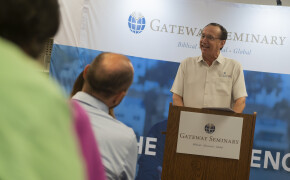Gateway Seminary closes Southern California Campus

Gateway Seminary’s Southern California Campus in Brea, Calif. officially closed July 27, in anticipation of moving academic operations to the Seminary’s new primary campus in Ontario, Calif.
Brea, Calif. (July 30, 2018)— Gateway Seminary’s Southern California Campus in Brea, Calif. officially closed July 27, in anticipation of moving academic operations to the Seminary’s new primary campus in Ontario, Calif.
The closing was marked with a ceremony attended by alumni, faculty and staff. It was the final step in Gateway’s transitioning the main campus from Mill Valley in Northern California to Ontario in Southern California. That move included a name change from Golden Gate Baptist Theological Seminary to Gateway Seminary, as well as opening a new regional campus in Fremont, Calif. that would continue the work the Seminary began in the San Francisco area nearly 75 years ago.
The story of the Southern California Campus began 45 years ago, when former trustee Guy Rutland Jr. from Georgia approached Dr. Harold Graves, then president of Golden Gate Baptist Theological Seminary, to ask about offering seminary classes in the Los Angeles, Calif. area. He had an idea that opening a satellite campus would aid the churches in Southern California.
It was an intriguing idea. In 1973, regional campuses were not a common concept, but Graves agreed to consider it. The Seminary’s faculty gathered for a conversation with Rutland and put together a potential academic program. Costs were estimated at $35,000 for the first year and $30,000 each subsequent year, with an additional $40,000 to $50,000 needed to fund the satellite program for two years. Rutland said he would guarantee that amount.
The six directors of missions in the Los Angeles area went to work compiling a mailing list of 320 pastors and other staff members who might be interested in seminary classes. Office and academic space was leased in Garden Grove, just south of Disneyland and near several freeways. Neighboring seminaries offered their libraries to students until the campus could build up its own resources. Trustees elected John Parrot, a New Mexico pastor, to serve as director of the new center.
The Southern California Campus was dedicated on September 9, 1973, and it flourished in Garden Grove until 1989, when Brea Center Baptist Church gifted property to the Seminary to relocate the campus to Brea.
During the closing ceremony, President Jeff Iorg noted that from 1973 to the mid 1980s, most of the records were kept as one seminary. But from the mid 1980s, records indicate that 1,634 individual students took classes in that location, with 601 graduates.
Dr. Roderick K. Durst, director of Gateway’s San Francisco Campus and former director of the Southern California Campus from 1991 to 1994, said he was a sophomore at California Baptist College in 1973 when a tall man with grey hair and a slight Southern accent spoke in chapel and began talking about the seminary in Garden Grove.
“Dr. Parrot was my first indication of a seminary professor,” Durst said. “He didn’t know he was speaking to a future director of the campus in chapel that day. I came here in 1991 to a brand new facility, and it was radically more multi-cultural than I was used to in Northern California. God sent us incredible students. It’s the generosity of a lot of people, who have put the wind in the sails of this campus, that made it possible for this to happen.”
Dr. Eddie Pate, professor of evangelism at Gateway Seminary and former director of the Southern California Campus from 2005 to 2007, said he and his family had just returned from 11 years of missionary service in Jordan and the Sudan, when he received a phone call asking if he would be interested in coming to the Seminary.
“Golden Gate was our seminary,” he said. “I grew up in Anaheim. This campus was in my stomping ground, and I knew these people. We moved back and loved it. I love this campus; I love these students. I had a preaching class with 17 students from 13 different nationalities. How cool it was that they would be preaching in 13 different languages.
What a place to teach students to reach the nations! I am grateful to play a small part in the development of leaders for the kingdom of God.”
In his closing remarks, Iorg said that the launch of the campus in 1973 was a departure from what had been done before.
“We took a leap and launched the effort to begin this work in Southern California.
Three years ago, the Seminary did it again. We took another step of faith to reestablish the Seminary in Southern California for a new generation. We are poised now for a future that a few years ago we didn’t anticipate. We made a remarkable decision — we would move away from the place that meant so much to us and establish a new work for a new generation.”
Iorg said that the importance of a sense of place and a sense of memorialization lasted a generation or two, but even those would pass away.
“The Mill Valley location was significant to a lot of people. Some of you would say the same about this piece of property. The Bible does talk about the importance of place, but it also talks about the dangers of placing too much importance on place. While place and memory is important, it is not ultimately important. It is important to remember what happened here, but it’s more of a marker to remind us that God has more to do, and we want to be in step with that. I am glad to be in the generation of people setting the stage for what is going to happen for future generations.”
-30-
